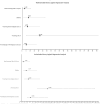Predictive demographic and clinical features for the development of dysthyroid optic neuropathy in a multi-ethnic TED population: a retrospective cohort study
- PMID: 40691639
- PMCID: PMC12281705
- DOI: 10.1186/s13044-025-00249-4
Predictive demographic and clinical features for the development of dysthyroid optic neuropathy in a multi-ethnic TED population: a retrospective cohort study
Abstract
Background: Dysthyroid Optic Neuropathy (DON) is a sight-threatening complication of Thyroid Eye Disease (TED). This study aims to identify the risk and predictive factors for DON in a multi-ethnic TED cohort.
Methods: Retrospective, cohort study of consecutive TED patients attending a multidisciplinary service over an 11-year period. Consecutive patients aged over 18 years old with a minimum of 6 months follow-up post-diagnosis of TED were included. We compared those patients with DON and those without (no-DON) to determine which factors were more prevalent in patients with DON.
Results: There were 26 and 516 consecutive patients with DON and no-DON. The DON prevalence in the cohort was 5.0%. The DON group had a Mean Age at TED Diagnosis (MATD) of 57.8 vs. 46.1 years in the no-DON group. The mean presenting CAS, TRAb and Gorman Diplopia Score (GDS) were significantly higher 3.73 ± 1.80, 2.76 ± 1.05 and 11.31 ± 11.90 vs. 0.54 ± 0.80, 0.48 ± 0.90 and 6.95 ± 9.22 in the DON compared to the no-DON group respectively (p = 0.00, p = 0.00 and p = 0.04). On multivariable regression, we found the following risk factors for developing DON (Odds Ratios): MATD ≥ 53 years (5.2 p = 0.00), presenting CAS ≥ 4 (P = 0.00), presenting GDS ≥ 3 (7.5 p = 0.00), diabetes (5.7 p = 0.00), and baseline TRAb ≥ 5.0 IU/L (2.9 p = 0.04).
Conclusion: Patients with diabetes, increased MATD, and high presenting CAS, GDS, and TRAb are at increased risk of developing DON in our cohort. Clinicians should be especially vigilant of the risk of sight-threatening complications in TED patients with more than one of the above risk factors.
Keywords: Dysthyroid optic neuropathy; Graves orbitopathy; Risk factors; Thyroid eye disease.
© 2025. The Author(s).
Conflict of interest statement
Declarations. Ethics approval and consent to participate: The study was approved by the institutional audit department and was conducted by the tenets of the Declaration of Helsinki and all laws in the United Kingdom. Consent for publication: Not applicable. Competing interests: Miss Vickie Lee is the Principal Investigator for the Horizon, Viridian, Lassen and Sling Trials, BOPSS National Lead for Thyroid Eye Disease and has been a consultant for Horizon/Amgen and Viridian Pharmaceuticals. Mr Malik Moledina is: Sub Investigator for the Viridian, Horizon and Sling Trial. Miss Ourania Fydanaki, Miss Gabriella Guevara & Dr Nour Houbby are Sub Investigators for the Horizon Trial. Dr Claire Feeney is a Pfizer employee in an unrelated field since June 2018. This paper was recently presented at ESOPRS Rotterdam 2024, and formed part of the submission that went on to win the ESOPRS Richard Collins Prize 2024.
Figures




Similar articles
-
Radiological Activity Score (RAS)-MRI Characteristics in Dysthyroid Optic Neuropathy in a Multi-Ethnic Thyroid Eye Disease Population.Clin Endocrinol (Oxf). 2025 Sep;103(3):385-395. doi: 10.1111/cen.15272. Epub 2025 May 20. Clin Endocrinol (Oxf). 2025. PMID: 40391843 Free PMC article.
-
Signs and symptoms to determine if a patient presenting in primary care or hospital outpatient settings has COVID-19.Cochrane Database Syst Rev. 2022 May 20;5(5):CD013665. doi: 10.1002/14651858.CD013665.pub3. Cochrane Database Syst Rev. 2022. PMID: 35593186 Free PMC article.
-
Sertindole for schizophrenia.Cochrane Database Syst Rev. 2005 Jul 20;2005(3):CD001715. doi: 10.1002/14651858.CD001715.pub2. Cochrane Database Syst Rev. 2005. PMID: 16034864 Free PMC article.
-
Surgical orbital decompression for thyroid eye disease.Cochrane Database Syst Rev. 2011 Dec 7;(12):CD007630. doi: 10.1002/14651858.CD007630.pub2. Cochrane Database Syst Rev. 2011. PMID: 22161415
-
Comparison of Two Modern Survival Prediction Tools, SORG-MLA and METSSS, in Patients With Symptomatic Long-bone Metastases Who Underwent Local Treatment With Surgery Followed by Radiotherapy and With Radiotherapy Alone.Clin Orthop Relat Res. 2024 Dec 1;482(12):2193-2208. doi: 10.1097/CORR.0000000000003185. Epub 2024 Jul 23. Clin Orthop Relat Res. 2024. PMID: 39051924
References
-
- Chin YH, Ng CH, Lee MH, Koh JWH, Kiew J, Yang SP, et al. Prevalence of thyroid eye disease in graves’ disease: A meta-analysis and systematic review. Clin Endocrinol (Oxford). 2020;93(4):363–74. 10.1111/cen.14296. - PubMed
-
- Wiersinga WM, Bartalena L. Epidemiology and prevention of graves’ ophthalmopathy. Thyroid. 2002;12(10):855–60. 10.1089/105072502761016476. - PubMed
LinkOut - more resources
Full Text Sources

